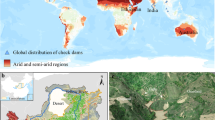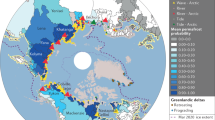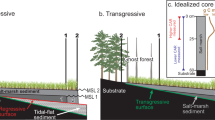Abstract
River deltas have contributed to atmospheric carbon regulation throughout Earth history, but functioning in the modern era has been impaired by reduced sediment loads, altered hydrologic regimes, increased global sea-level rise and accelerated subsidence. Delta restoration involves environmental engineering via river diversions, which utilize self-organizing processes to create prograding deltas. Here we analyse sediment cores from Wax Lake delta, a product of environmental engineering, to quantify the burial of organic carbon. We find that, despite relatively low concentrations of organic carbon measured in the cores (about 0.4%), the accumulation of about 3 T m−2 of sediment over the approximate 60 years of delta building resulted in the burial of a significant amount of organic carbon (16 kg m−2). This equates to an apparent organic carbon accumulation rate of 250 ± 23 g m−2 yr−1, which implicitly includes losses by carbon emissions and erosion. Our estimated accumulation rate for Wax Lake delta is substantially greater than previous estimates based on the top metre of delta sediments and comparable to those of coastal mangrove and marsh habitats. The sedimentation of carbon at the Wax Lake delta demonstrates the capacity of engineered river diversions to enhance both coastal accretion and carbon burial.
This is a preview of subscription content, access via your institution
Access options
Access Nature and 54 other Nature Portfolio journals
Get Nature+, our best-value online-access subscription
$29.99 / 30 days
cancel any time
Subscribe to this journal
Receive 12 print issues and online access
$259.00 per year
only $21.58 per issue
Buy this article
- Purchase on Springer Link
- Instant access to full article PDF
Prices may be subject to local taxes which are calculated during checkout




Similar content being viewed by others
References
Hedges, J. I. & Keil, R. G. Sedimentary organic matter preservation: an assessment and speculative synthesis. Mar. Chem. 49, 137–139 (1995).
Burdige, D. J. Burial of terrestrial organic matter in marine sediments: a re-assessment. Glob. Biogeochem. Cycles 19, GB4011 (2005).
Smith, R. W., Bianchi, T. S., Allison, M., Savage, C. & Galy, V. High rates of organic carbon burial in fjord sediments globally. Nat. Geosci. 8, 450–453 (2015).
Bianchi, T. S. & Allison, M. A. Large-river delta-front estuaries as natural ‘recorders’ of global environmental change. Proc. Natl Acad. Sci. USA 106, 8085–8092 (2009).
Berner, R. A. Burial of organic carbon and pyrite sulfur in the modern ocean: its geochemical and environmental significance. Am. J. Sci. 282, 451–473 (1982).
McLeod, E. et al. A blueprint for blue carbon: toward an improved understanding of the role of vegetated coastal habitats in sequestering CO2 . Front. Ecol. Environ. 9, 552–560 (2011).
Syvitski, J. P. M. et al. Sinking deltas due to human activities. Nat. Geosci. 2, 681–686 (2009).
Giosan, L., Syvitski, J., Constantinescu, S. & Day, J. Protect the world’s deltas. Nature 516, 31–33 (2014).
Tessler, Z. D. et al. Profiling risk and sustainability in coastal deltas of the world. Science 349, 638–643 (2015).
Meade, R. H. & Moody, J. A. Causes for the decline of suspended-sediment discharge in the Mississippi River system, 1940–2007. Hydrol. Process. 2274, 35–49 (2009).
Horowitz, A. J. A quarter century of declining suspended sediment fluxes in the Mississippi River and the effect of the 1993 flood. Hydrol. Process. 2274, 13–34 (2009).
Alexander, J., Wilson, R. & Green, W. A Brief History and Summary of the Effects of River Engineering and Dams on the Mississippi River System and Delta. Circular 1375 (US Geological Survey, 2012).
Kolker, A. S., Allison, M. A. & Hameed, S. An evaluation of subsidence rates and sea-level variability in the northern Gulf of Mexico. Geophys. Res. Lett. 38, L21404 (2011).
Couvillion, B. R. et al. Land Area Change in Coastal Louisiana from 1932 to 2010Scientific Investigations Map 3164 (US Geological Survey, 2011).
Couvillion, B. R., Steyer, G. D., Wang, H., Beck, H. J. & Rybczyk, J. M. Forecasting the effects of coastal protection and restoration projects on wetland morphology in coastal louisiana under multiple environmental uncertainty scenarios. J. Coast. Res. 67, 29–50 (2013).
DeLaune, R. D. & White, J. R. Will coastal wetlands continue to sequester carbon in response to an increase in global sea level?: A case study of the rapidly subsiding Mississippi river deltaic plain. Climatic Change 110, 297–314 (2012).
LACPRA Louisiana’s Comprehensive Master Plan for a Sustainable Coast (Coastal Protection and Restoration Authority of Louisiana, 2017).
Day, J. W. et al. Large infrequently operated river diversions for Mississippi delta restoration. Estuar. Coast. Shelf Sci. 183, 292–303 (2016).
Paola, C. et al. Natural processes in delta restoration: application to the Mississippi Delta. Ann. Rev. Mar. Sci. 3, 67–91 (2011).
Mossa, J. The changing geomorphology of the Atchafalaya River, Louisiana: a historical perspective. Geomorphology 252, 112–127 (2016).
Allison, M. A. et al. A water and sediment budget for the lower Mississippi–Atchafalaya River in flood years 2008–2010 implications for sediment discharge to the oceans and coastal restoration in Louisiana. J. Hydrol. 432, 84–97 (2012).
Wellner, R., Beaubouef, R., Van Wagoner, J., Roberts, H. & Sun, T. Jet-plume depositional bodies—the primary building blocks of Wax Lake Delta. Gulf Coast Assoc. Geol. Soc. Trans. 55, 867–909 (2005).
Allen, Y. C., Couvillion, B. R. & Barras, J. a. Using multitemporal remote sensing imagery and inundation measures to improve land change estimates in coastal wetlands. Estuar. Coasts 35, 190–200 (2012).
Shaw, J. B., Mohrig, D. & Whitman, S. K. The morphology and evolution of channels on the Wax Lake Delta, Louisiana, USA. J. Geophys. Res. 118, 1562–1584 (2013).
Roberts, H. & Sneider, J. Atchafalaya-Wax Lake Deltas: The New Regressive Phase of the Mississippi River Delta ComplexA Field Seminar for the 2003 GCAGS Convention (Louisiana Geological Survey, 2003).
Shelmon, R. Deltas: Models for Exploration 209–221 (Houston Geological Society, 1975).
Shaw, J. B. et al. Airborne radar imaging of subaqueous channel evolution in Wax Lake Delta, Louisiana, USA. Geophys. Res. Lett. 43, 5035–5042 (2016).
Edmonds, D. A., Shaw, J. B. & Mohrig, D. Topset-dominated deltas: a new model for river delta stratigraphy. Geology 39, 1175–1178 (2011).
Johnson, W. B., Sasser, C. E. & Gosselink, J. G. Succession of vegetation in an evolving river delta, Atchafalaya Bay, Louisiana. J. Ecol. 73, 973–986 (1985).
Carle, M., SasserC., E. & Roberts, H. H., V. Accretion and vegetation community change in the Wax Lake Delta following the historic 2011 Mississippi River flood. J. Coast. Res. 31, 569–587 (2013).
Shields, M. R., Bianchi, T. S., Gélinas, Y., Allison, M. A. & Twilley, R. R. Enhanced terrestrial carbon preservation promoted by reactive iron in deltaic sediments. Geophys. Res. Lett. 43, 1149–1157 (2016).
Carle, M. V. & Sasser, C. E. Productivity and resilience: long-term trends and storm-driven fluctuations in the plant community of the accreting Wax Lake Delta. Estuar. Coasts 39, 406–422 (2015).
Carle, M. V., Wang, L. & Sasser, C. E. Mapping freshwater marsh species distributions using WorldView-2 high-resolution multispectral satellite imagery. Int. J. Remote Sens. 35, 4698–4716 (2014).
Gabler, C. A. et al. Macroclimatic change expected to transform coastal wetland ecosystems this century. Nat. Clim. Change 7, 142–147 (2017).
Comeaux, R. S., Allison, M. A. & Bianchi, T. S. Mangrove expansion in the Gulf of Mexico with climate change: implications for wetland health and resistance to rising sea levels. Estuar. Coast. Shelf Sci. 96, 81–95 (2012).
Bianchi, T. S. et al. Historical reconstruction of mangrove expansion in the Gulf of Mexico: linking climate change with carbon sequestration in coastal wetlands. Estuar. Coast. Shelf Sci. 119, 7–16 (2013).
Mitra, S., Wassmann, R. & Vlek, P. L. G. An appraisal of global wetlands area and its organic carbon stock. Curr. Sci. 88, 25–35 (2005).
Roden, E. E. Diversion of electron flow from methanogenesis to crystalline Fe(III) Oxide reduction in carbon-limited cultures of wetland sediment microorganisms diversion of electron flow from methanogenesis to crystalline Fe(III) oxide reduction in carbon-limit. Society 69, 5702–5706 (2003).
Roden, E. E. & Wetzel, R. G. Organic carbon oxidation and suppression of methane production by microbial Fe(III) oxide reduction in vegetated and unvegetated freshwater wetland sediments. Limnol. Oceanogr. 41, 1733–1748 (1996).
Poulton, S. W. & Raiswell, R. The low-temperature geochemical cycle of iron: from continental fluxes to marine sediment deposition. Am. J. Sci. 302, 774–805 (2002).
Lalonde, K., Mucci, A., Ouellet, A. & Gélinas, Y. Preservation of organic matter in sediments promoted by iron. Nature 483, 198–200 (2012).
Bianchi, T. S., Pennock, J. R. & Twilley, R. R. Biogeochemistry of Gulf of Mexico Estuaries (John Wiley, 1999).
Vile, M. A., Bridgham, S. D. & Kelman Wieder, R. Response of anaerobic carbon mineralization rates to sulfate amendments in a boreal peatland. Ecol. Appl. 13, 720–734 (2003).
Mitsch, W. J. et al. Reducing nitrogen loading to the Gulf of Mexico from the Mississippi River basin: strategies to counter a persistent ecological problem. Bioscience 51, 373–388 (2001).
Yu, K., DeLaune, R. D. & Boeckx, P. Direct measurement of denitrification activity in a Gulf coast freshwater marsh receiving diverted Mississippi River water. Chemosphere 65, 2449–2455 (2006).
Walker, J. T., Stow, C. A. & Geron, C. Nitrous oxide emissions from the Gulf of Mexico hypoxic zone. Environ. Sci. Technol. 44, 1617–1623 (2010).
Brown, S. et al. 2017 Coastal Master Plan: Appendix C: ModelingCh. 3 (Coastal Protection and Restoration Authority of Louisiana, 2017).
Peyronnin, N. et al. Optimizing sediment diversion operations: working group recommendations for integrating complex ecological and social landscape interactions. Water 9, 368 (2017).
Syvitski, J. P. M. & Milliman, J. D. Geology, geography, and humans battle for dominance over the delivery of fluvial sediment to the coastal ocean. J. Geol. 115, 1–19 (2007).
Milliman, J. D. & Syvitski, J. P. M. Geomorphic/tectonic control of sediment discharge to the Ocean: the importance of small mountainous rivers. J. Geol. 100, 525–544 (1992).
Roberts, H. H., Coleman, J. M., Bentley, S. J. & Walker, N. An embryonic major delta lobe: a new generation of delta studies in the Atchafalaya-Wax Lake Delta system. Gulf Coast Assoc. Geol. Soc. Trans. 53, 690–703 (2003).
Kim, W., Mohrig, D., Twilley, R., Paola, C. & Parker, G. Is it feasible to build New Land in the Mississippi river delta? Eos 90, 373–384 (2009).
Shaw, J. B., Mohrig, D. & Wagner, R. W. Flow patterns and morphology of a prograding river delta. J. Geophys. Res. 121, 372–291 (2016).
Seybold, H., Andrade, J. S., Herrmann, H. J., Andrade, J. S. Jr & Herrmann, H. J. Modeling river delta formation. Proc. Natl Acad. Sci. USA 104, 16804–16809 (2007).
Edmonds, D. A. & Slingerland, R. L. Mechanics of river mouth bar formation: implications for the morphodynamics of delta distributary networks. J. Geophys. Res. 112, F02034 (2007).
Wolinsky, M. A., Edmonds, D. A., Martin, J. & Paola, C. Delta allometry: growth laws for river deltas. Geophys. Res. Lett. 37, L21403 (2010).
Wagner, W. et al. Elevation change and stability on a prograding delta. Geophys. Res. Lett. 44, 1786–1794 (2017).
Henry, K. M. & Twilley, R. R. Nutrient biogeochemistry during the early stages of delta development in the Mississippi River deltaic plain. Ecosystems 17, 1–17 (2014).
Arnold, S. L. & Schepers, J. S. A simple Roller-Mill grinding procedure for plant and soil samples. Commun. Soil Sci. Plant Anal. 35, 537–545 (2004).
Rosen, P. A. et al. UAVSAR: a new NASA airborne SAR system for science and technology research. In 2006 IEEE Conf. Radar 22–29 (IEEE, 2006); http://dx.doi.org/10.1109/RADAR.2006.1631770
Rouse, J. W., Haas, R. H., Schell, J. A. & Deering, D. W. Monitoring vegetation systems in the Great Plains with ERTS. In 3rd Earth Resour. Technol. Satell. Symp. Vol. 1, 309–317 (NASA, 1974).
R Core Team R: A Language and Environment for Statistical Computing (2016).
Davison, A. C., Hinkley, D. V. & Schechtman, E. Efficient bootstrap simulation. Biometrika 73, 555–566 (1986).
Acknowledgements
We thank the Gulf Coast Association of Geological Societies (GCAGS) for the student grant that supported our field work. The Jon and Beverly Thompson Chair in Geological Sciences at University of Florida provided support for the laboratory analyses.
Author information
Authors and Affiliations
Contributions
M.R.S., T.S.B. and D.M. determined the sampling strategy. M.R.S. and A.S.K. collected the cores. M.R.S. and J.H.C. conducted the laboratory analyses. M.R.S. and J.A.H. conducted the data processing and statistical analyses. M.R.S., T.S.B., D.M., J.A.H., W.F.K., A.S.K. and J.H.C. critically analysed the results and wrote the paper.
Corresponding author
Ethics declarations
Competing interests
The authors declare no competing financial interests.
Supplementary information
Supplementary Information
Supplementary Information (PDF 897 kb)
Supplementary Information
Supplementary Information (TXT 8878 kb)
Supplementary Information
Supplementary Information (TXT 8875 kb)
Supplementary Information
Supplementary Information (CSV 4 kb)
Supplementary Information
Supplementary Information (XLSX 16 kb)
Rights and permissions
About this article
Cite this article
Shields, M., Bianchi, T., Mohrig, D. et al. Carbon storage in the Mississippi River delta enhanced by environmental engineering. Nature Geosci 10, 846–851 (2017). https://doi.org/10.1038/ngeo3044
Received:
Accepted:
Published:
Issue Date:
DOI: https://doi.org/10.1038/ngeo3044
This article is cited by
-
Cold fronts control multiscale spatiotemporal hydroperiod patterns in a man-made subtropical coastal delta (Wax Lake Region, Louisiana USA)
Ocean Dynamics (2024)
-
Coastal vegetation and estuaries are collectively a greenhouse gas sink
Nature Climate Change (2023)
-
Ice-dominated Arctic deltas
Nature Reviews Earth & Environment (2022)
-
High rates of organic carbon burial in submarine deltas maintained on geological timescales
Nature Geoscience (2022)
-
Benthic Biofilm Potential for Organic Carbon Accumulation in Salt Marsh Sediments
Wetlands (2022)



